Tinoosh Mohsenin
MedMambaLite: Hardware-Aware Mamba for Medical Image Classification
Aug 07, 2025Abstract:AI-powered medical devices have driven the need for real-time, on-device inference such as biomedical image classification. Deployment of deep learning models at the edge is now used for applications such as anomaly detection and classification in medical images. However, achieving this level of performance on edge devices remains challenging due to limitations in model size and computational capacity. To address this, we present MedMambaLite, a hardware-aware Mamba-based model optimized through knowledge distillation for medical image classification. We start with a powerful MedMamba model, integrating a Mamba structure for efficient feature extraction in medical imaging. We make the model lighter and faster in training and inference by modifying and reducing the redundancies in the architecture. We then distill its knowledge into a smaller student model by reducing the embedding dimensions. The optimized model achieves 94.5% overall accuracy on 10 MedMNIST datasets. It also reduces parameters 22.8x compared to MedMamba. Deployment on an NVIDIA Jetson Orin Nano achieves 35.6 GOPS/J energy per inference. This outperforms MedMamba by 63% improvement in energy per inference.
Multi-RAG: A Multimodal Retrieval-Augmented Generation System for Adaptive Video Understanding
May 29, 2025Abstract:To effectively engage in human society, the ability to adapt, filter information, and make informed decisions in ever-changing situations is critical. As robots and intelligent agents become more integrated into human life, there is a growing opportunity-and need-to offload the cognitive burden on humans to these systems, particularly in dynamic, information-rich scenarios. To fill this critical need, we present Multi-RAG, a multimodal retrieval-augmented generation system designed to provide adaptive assistance to humans in information-intensive circumstances. Our system aims to improve situational understanding and reduce cognitive load by integrating and reasoning over multi-source information streams, including video, audio, and text. As an enabling step toward long-term human-robot partnerships, Multi-RAG explores how multimodal information understanding can serve as a foundation for adaptive robotic assistance in dynamic, human-centered situations. To evaluate its capability in a realistic human-assistance proxy task, we benchmarked Multi-RAG on the MMBench-Video dataset, a challenging multimodal video understanding benchmark. Our system achieves superior performance compared to existing open-source video large language models (Video-LLMs) and large vision-language models (LVLMs), while utilizing fewer resources and less input data. The results demonstrate Multi- RAG's potential as a practical and efficient foundation for future human-robot adaptive assistance systems in dynamic, real-world contexts.
RAFT: Robust Augmentation of FeaTures for Image Segmentation
May 07, 2025Abstract:Image segmentation is a powerful computer vision technique for scene understanding. However, real-world deployment is stymied by the need for high-quality, meticulously labeled datasets. Synthetic data provides high-quality labels while reducing the need for manual data collection and annotation. However, deep neural networks trained on synthetic data often face the Syn2Real problem, leading to poor performance in real-world deployments. To mitigate the aforementioned gap in image segmentation, we propose RAFT, a novel framework for adapting image segmentation models using minimal labeled real-world data through data and feature augmentations, as well as active learning. To validate RAFT, we perform experiments on the synthetic-to-real "SYNTHIA->Cityscapes" and "GTAV->Cityscapes" benchmarks. We managed to surpass the previous state of the art, HALO. SYNTHIA->Cityscapes experiences an improvement in mIoU* upon domain adaptation of 2.1%/79.9%, and GTAV->Cityscapes experiences a 0.4%/78.2% improvement in mIoU. Furthermore, we test our approach on the real-to-real benchmark of "Cityscapes->ACDC", and again surpass HALO, with a gain in mIoU upon adaptation of 1.3%/73.2%. Finally, we examine the effect of the allocated annotation budget and various components of RAFT upon the final transfer mIoU.
ATLASv2: LLM-Guided Adaptive Landmark Acquisition and Navigation on the Edge
Apr 15, 2025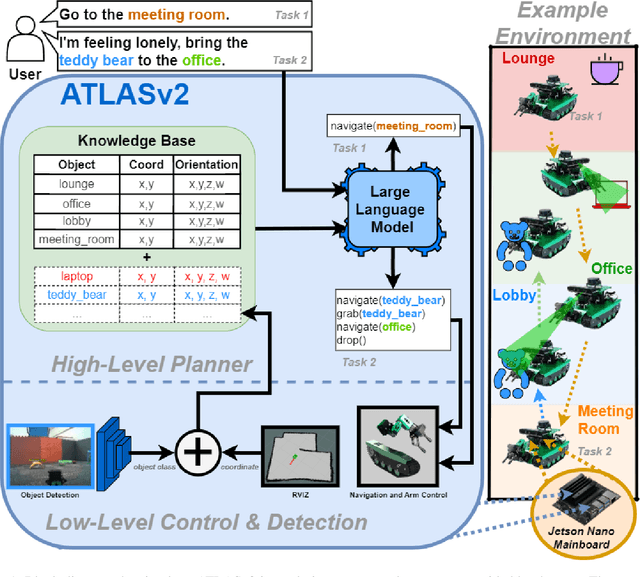
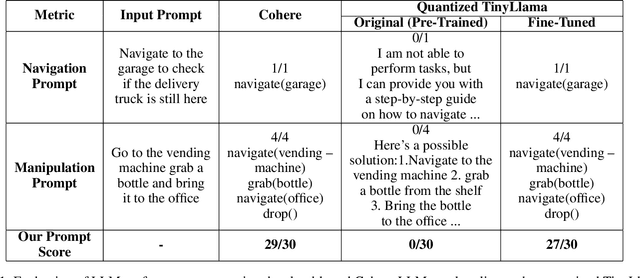

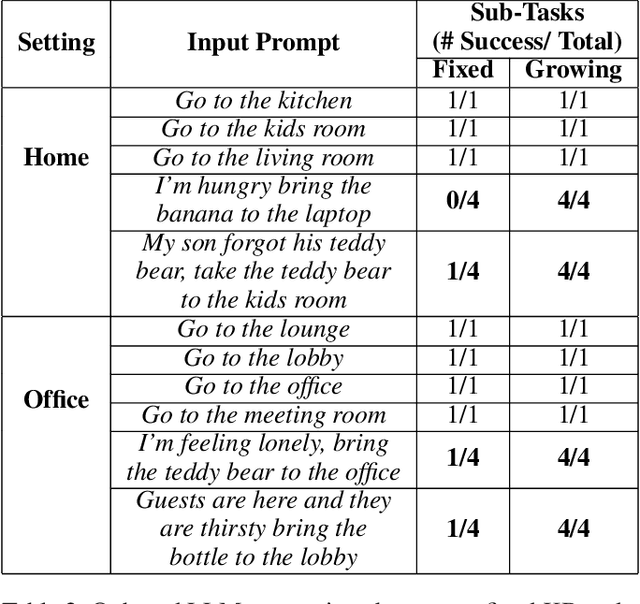
Abstract:Autonomous systems deployed on edge devices face significant challenges, including resource constraints, real-time processing demands, and adapting to dynamic environments. This work introduces ATLASv2, a novel system that integrates a fine-tuned TinyLLM, real-time object detection, and efficient path planning to enable hierarchical, multi-task navigation and manipulation all on the edge device, Jetson Nano. ATLASv2 dynamically expands its navigable landmarks by detecting and localizing objects in the environment which are saved to its internal knowledge base to be used for future task execution. We evaluate ATLASv2 in real-world environments, including a handcrafted home and office setting constructed with diverse objects and landmarks. Results show that ATLASv2 effectively interprets natural language instructions, decomposes them into low-level actions, and executes tasks with high success rates. By leveraging generative AI in a fully on-board framework, ATLASv2 achieves optimized resource utilization with minimal prompting latency and power consumption, bridging the gap between simulated environments and real-world applications.
MambaLiteSR: Image Super-Resolution with Low-Rank Mamba using Knowledge Distillation
Feb 19, 2025Abstract:Generative Artificial Intelligence (AI) has gained significant attention in recent years, revolutionizing various applications across industries. Among these, advanced vision models for image super-resolution are in high demand, particularly for deployment on edge devices where real-time processing is crucial. However, deploying such models on edge devices is challenging due to limited computing power and memory. In this paper, we present MambaLiteSR, a novel lightweight image Super-Resolution (SR) model that utilizes the architecture of Vision Mamba. It integrates State Space Blocks and a reconstruction module for efficient feature extraction. To optimize efficiency without affecting performance, MambaLiteSR employs knowledge distillation to transfer key insights from a larger Mamba-based teacher model to a smaller student model via hyperparameter tuning. Through mathematical analysis of model parameters and their impact on PSNR, we identify key factors and adjust them accordingly. Our comprehensive evaluation shows that MambaLiteSR outperforms state-of-the-art edge SR methods by reducing power consumption while maintaining competitive PSNR and SSIM scores across benchmark datasets. It also reduces power usage during training via low-rank approximation. Moreover, MambaLiteSR reduces parameters with minimal performance loss, enabling efficient deployment of generative AI models on resource-constrained devices. Deployment on the embedded NVIDIA Jetson Orin Nano confirms the superior balance of MambaLiteSR size, latency, and efficiency. Experiments show that MambaLiteSR achieves performance comparable to both the baseline and other edge models while using 15% fewer parameters. It also improves power consumption by up to 58% compared to state-of-the-art SR edge models, all while maintaining low energy use during training.
Decentralised Resource Sharing in TinyML: Wireless Bilayer Gossip Parallel SGD for Collaborative Learning
Jan 08, 2025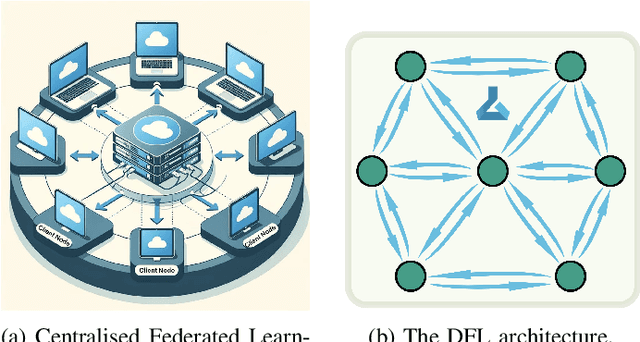

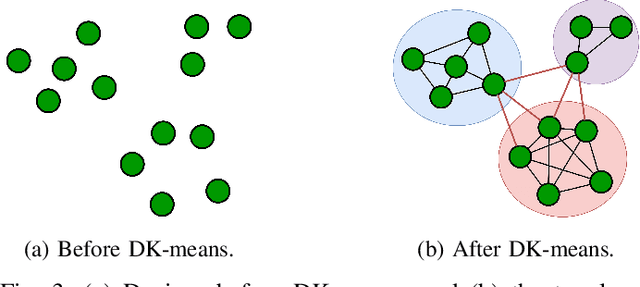
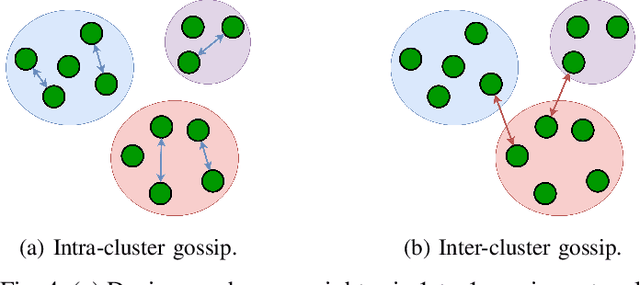
Abstract:With the growing computational capabilities of microcontroller units (MCUs), edge devices can now support machine learning models. However, deploying decentralised federated learning (DFL) on such devices presents key challenges, including intermittent connectivity, limited communication range, and dynamic network topologies. This paper proposes a novel framework, bilayer Gossip Decentralised Parallel Stochastic Gradient Descent (GD PSGD), designed to address these issues in resource-constrained environments. The framework incorporates a hierarchical communication structure using Distributed Kmeans (DKmeans) clustering for geographic grouping and a gossip protocol for efficient model aggregation across two layers: intra-cluster and inter-cluster. We evaluate the framework's performance against the Centralised Federated Learning (CFL) baseline using the MCUNet model on the CIFAR-10 dataset under IID and Non-IID conditions. Results demonstrate that the proposed method achieves comparable accuracy to CFL on IID datasets, requiring only 1.8 additional rounds for convergence. On Non-IID datasets, the accuracy loss remains under 8\% for moderate data imbalance. These findings highlight the framework's potential to support scalable and privacy-preserving learning on edge devices with minimal performance trade-offs.
Energy-Aware FPGA Implementation of Spiking Neural Network with LIF Neurons
Nov 03, 2024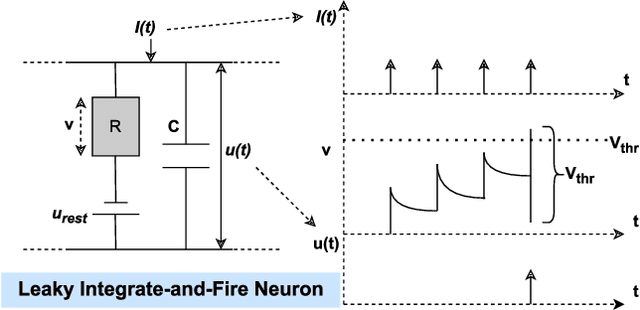

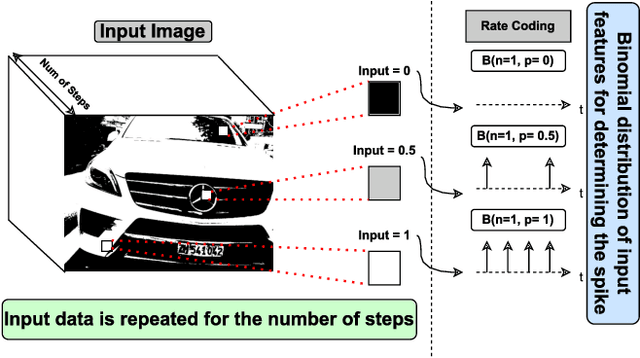

Abstract:Tiny Machine Learning (TinyML) has become a growing field in on-device processing for Internet of Things (IoT) applications, capitalizing on AI algorithms that are optimized for their low complexity and energy efficiency. These algorithms are designed to minimize power and memory footprints, making them ideal for the constraints of IoT devices. Within this domain, Spiking Neural Networks (SNNs) stand out as a cutting-edge solution for TinyML, owning to their event-driven processing paradigm which offers an efficient method of handling dataflow. This paper presents a novel SNN architecture based on the 1st Order Leaky Integrate-and-Fire (LIF) neuron model to efficiently deploy vision-based ML algorithms on TinyML systems. A hardware-friendly LIF design is also proposed, and implemented on a Xilinx Artix-7 FPGA. To evaluate the proposed model, a collision avoidance dataset is considered as a case study. The proposed SNN model is compared to the state-of-the-art works and Binarized Convolutional Neural Network (BCNN) as a baseline. The results show the proposed approach is 86% more energy efficient than the baseline.
TinyM$^2$Net-V3: Memory-Aware Compressed Multimodal Deep Neural Networks for Sustainable Edge Deployment
May 20, 2024Abstract:The advancement of sophisticated artificial intelligence (AI) algorithms has led to a notable increase in energy usage and carbon dioxide emissions, intensifying concerns about climate change. This growing problem has brought the environmental sustainability of AI technologies to the forefront, especially as they expand across various sectors. In response to these challenges, there is an urgent need for the development of sustainable AI solutions. These solutions must focus on energy-efficient embedded systems that are capable of handling diverse data types even in environments with limited resources, thereby ensuring both technological progress and environmental responsibility. Integrating complementary multimodal data into tiny machine learning models for edge devices is challenging due to increased complexity, latency, and power consumption. This work introduces TinyM$^2$Net-V3, a system that processes different modalities of complementary data, designs deep neural network (DNN) models, and employs model compression techniques including knowledge distillation and low bit-width quantization with memory-aware considerations to fit models within lower memory hierarchy levels, reducing latency and enhancing energy efficiency on resource-constrained devices. We evaluated TinyM$^2$Net-V3 in two multimodal case studies: COVID-19 detection using cough, speech, and breathing audios, and pose classification from depth and thermal images. With tiny inference models (6 KB and 58 KB), we achieved 92.95% and 90.7% accuracies, respectively. Our tiny machine learning models, deployed on resource limited hardware, demonstrated low latencies within milliseconds and very high power efficiency.
TinyVQA: Compact Multimodal Deep Neural Network for Visual Question Answering on Resource-Constrained Devices
Apr 04, 2024

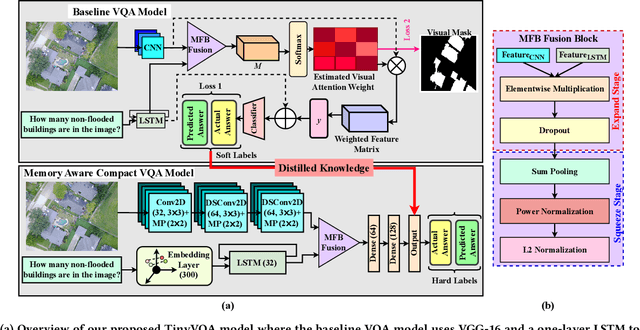
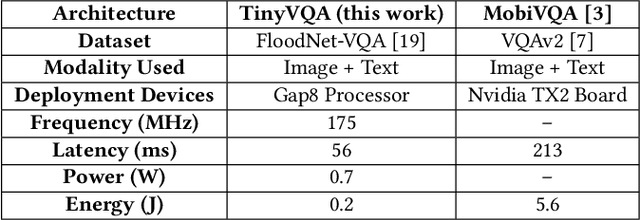
Abstract:Traditional machine learning models often require powerful hardware, making them unsuitable for deployment on resource-limited devices. Tiny Machine Learning (tinyML) has emerged as a promising approach for running machine learning models on these devices, but integrating multiple data modalities into tinyML models still remains a challenge due to increased complexity, latency, and power consumption. This paper proposes TinyVQA, a novel multimodal deep neural network for visual question answering tasks that can be deployed on resource-constrained tinyML hardware. TinyVQA leverages a supervised attention-based model to learn how to answer questions about images using both vision and language modalities. Distilled knowledge from the supervised attention-based VQA model trains the memory aware compact TinyVQA model and low bit-width quantization technique is employed to further compress the model for deployment on tinyML devices. The TinyVQA model was evaluated on the FloodNet dataset, which is used for post-disaster damage assessment. The compact model achieved an accuracy of 79.5%, demonstrating the effectiveness of TinyVQA for real-world applications. Additionally, the model was deployed on a Crazyflie 2.0 drone, equipped with an AI deck and GAP8 microprocessor. The TinyVQA model achieved low latencies of 56 ms and consumes 693 mW power while deployed on the tiny drone, showcasing its suitability for resource-constrained embedded systems.
Squeezed Edge YOLO: Onboard Object Detection on Edge Devices
Dec 18, 2023



Abstract:Demand for efficient onboard object detection is increasing due to its key role in autonomous navigation. However, deploying object detection models such as YOLO on resource constrained edge devices is challenging due to the high computational requirements of such models. In this paper, an compressed object detection model named Squeezed Edge YOLO is examined. This model is compressed and optimized to kilobytes of parameters in order to fit onboard such edge devices. To evaluate Squeezed Edge YOLO, two use cases - human and shape detection - are used to show the model accuracy and performance. Moreover, the model is deployed onboard a GAP8 processor with 8 RISC-V cores and an NVIDIA Jetson Nano with 4GB of memory. Experimental results show Squeezed Edge YOLO model size is optimized by a factor of 8x which leads to 76% improvements in energy efficiency and 3.3x faster throughout.
 Add to Chrome
Add to Chrome Add to Firefox
Add to Firefox Add to Edge
Add to Edge